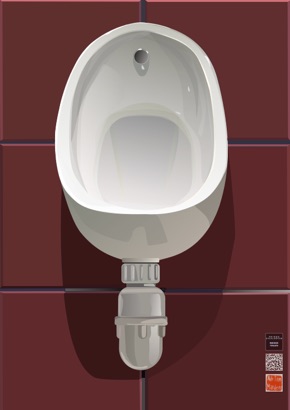Buy a print
INDOOR TOILETS
or This in not a Fountain !
The one piece, hygienic, self cleaning, virtually smell free toilet is so widely used today that we have forgotten the Georgian ‘Privy’. Often hidden in the cellar or in a hut discharging into the street this smelly, disease ridden, toilet had to be emptied by hand so was often left. Throughout Victorian towns the Dirt and Water Closets were slowly perfected. Until, with the construction of extensive sewer systems and local authority treatment plants, the water closet won out in the 1850s. Urinals were initially installed in public spaces or commercial buildings offering the advantages of water saving and a reduction of ‘splash back’, making cleaning easier.
HISTORY
The Indus Valley Civilization in India used toilets attached to simple flowing water sewage systems from about 2500 BC. Similar systems were used by the Romans and Egyptians. But the first Flushing toilet was invented by John Harington in 1596. However, it was not until the late 19th century that victorian entrepreneurs such as Thomas Crapper developed the U bend, the toilet pan and the flushing mechanisms we know today.
Even though the middle classes and well to do Victorians in the 1860s had flushing toilets they often discharged in unsafe ways. The Prince of Wales’ long illness in 1871 were attributed to faulty drains at Sandringham. They may also have contributed to Prince Albert’s typhoid and subsequent death ten years earlier.
in the 1840s Hector Gavin from the Health of Towns Association estimated that there was one privy for every 76 persons in Sunderland. Across the country many were ‘most dilapitated’ and dangerous to use. He reported that ‘one woman had fallen through a rotten privy floor and drowned in the filth underneath’.
Working class homes were still being built in the early 1900s with outside WC’s. Bathrooms became standard items in new low cost building after world war one. Although it was noted in 1904 that “it is downright inadmissible to have a a lavatory in a bathroom” in 1919 new, cost effective, houses in the London suburbs were being built with bathrooms that included a toilet.
MAKING
A liquid clay mix called slip is poured into a plaster mould and allowed to stand until it forms a ‘casting layer’ on the mould. The excess slip is poured away and the ‘green’ moulding released. It is allowed to stand and dry for one to three days. It is then cleaned up and finished before it is sent to a drying oven for 6 to 12 hours. A glaze is sprayed on the moulding and it is fired at 1250 degrees centigrade to make it hard and glossy.
DRAWING
The urinal’s smooth rounded shapes create subtle tones and faint shadows which defines the form.The bright surfaces catch the light and reflect the surroundings in subdued ways. These fine details have to merge and match to give a credible image, whilst the general tone of each area must relate to the whole. The tiles catch the light and create shadows at their edges. The bright interior lighting also casts a dark shadow of the fitting.

An image of the elements that were created to make the drawing




To order a print
click here to go to the PRINTS page.





















